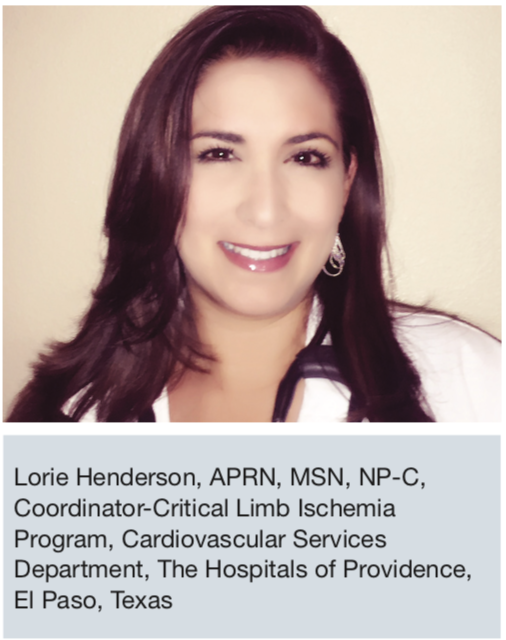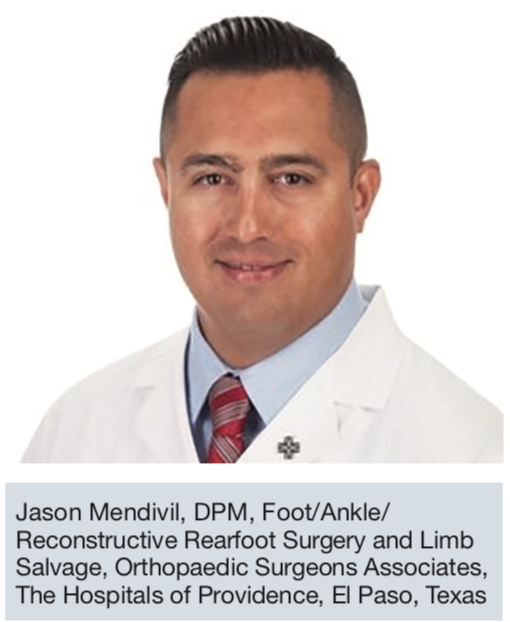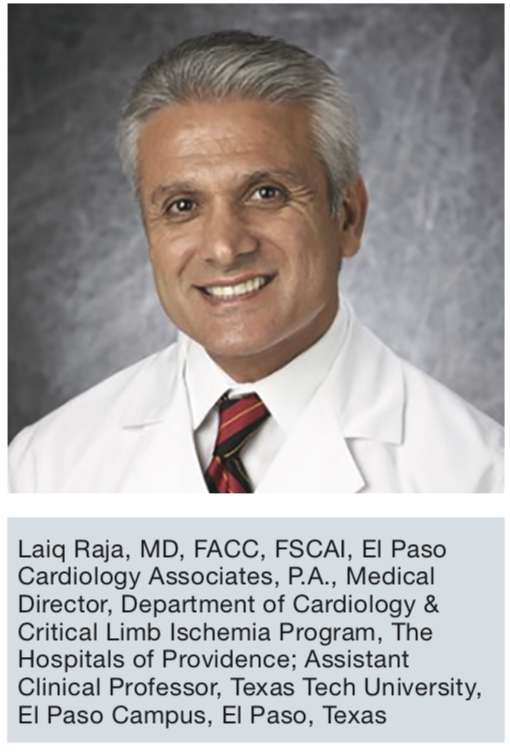ADVERTISEMENT
Critical Limb Ischemia Has Found a Care Pathway in El Paso, Texas


 This month, I welcome Laiq Raja, MD, FACC, FSCAI, Jason Mendivil, DPM, and Lorie Henderson, APRN, MSN, NP-C. Their approach to a critical limb ischemia (CLI) care pathway is not only saving limbs, but changing lives one leg at a time. — Gary Clifton, Vice President, Terumo Business Edge
This month, I welcome Laiq Raja, MD, FACC, FSCAI, Jason Mendivil, DPM, and Lorie Henderson, APRN, MSN, NP-C. Their approach to a critical limb ischemia (CLI) care pathway is not only saving limbs, but changing lives one leg at a time. — Gary Clifton, Vice President, Terumo Business Edge
Dr. Raja, can you please briefly describe your critical limb ischemia program and your involvement in managing this particular patient population?
Dr. Laiq Raja: In a few words, we are working to prevent unnecessary amputations. Patients with critical limb ischemia generally have poor outcomes, because they have poor follow-up. They are a specialized patient population with specific needs that require constant surveillance and interactions with multiple specialties to ensure that they have a successful outcome. Thus, we have established the concept of a “circle of care”, whereby a patient is introduced into the circle of care and is seen and treated by several key physicians, departments, and medical personnel. The various key components of the circle ensure that a patient is properly assessed, therapy is delivered, and there is constant care of their wound, getting us closer to that successful outcome.

As for myself, I am an interventional cardiologist by training, but from the beginning of my career, I recognized that peripheral arterial disease was under-diagnosed and under-treated. This was not an area most interventionalists venture into or have any vast experience or expertise with. Over the last decade and a half, I have made it my mission to not only help treat patients with this potentially devastating disease, but to further the development of the revascularization field among my peers. Through several industry partnerships, I am fortunate enough to be able spread my message, and share my techniques, successes, failures, and strategies to achieve positive outcomes for patients with peripheral arterial disease and critical limb ischemia. My goal is to one day “standardize” the way we as physicians treat critical limb ischemia, and that all patients have positive outcomes.
Dr. Mendivil, you are a DPM who has training in surgical techniques for amputation and reconstruction below the ankle. Please share more about your training with us, and how you and Dr. Raja work together to treat this population.

Dr. Jason Mendivil: There is a big difference in the training of the DPM now from that of the past. Now DPMs have a minimum of three years of training in reconstructive foot and ankle surgery that facilitates limb salvage surgery. There is a lot of biomechanics involved in the lower extremity and therefore, a lot of of attention needs to go into how we perform and conduct our reconstruction efforts to ensure we can provide the patient with as functional a foot as possible. The foot and ankle are a dynamic interplay of ligaments, tendons, and bones. Amputation of these structures can alter gait and create further lifelong complications for the patient.
CLI is a very co-morbid population. Typically, patients are diabetic and have peripheral arterial disease, and some degree of obesity is not uncommon. Our healthcare system is far too quick to send patients for amputation. Much like coronary disease, this is all about blood flow and preventing tissue loss. More specifically, it is about targeted vessel revascularization. If I am going to prevent a below-the-knee (BTK) amputation because of problems in the foot, I need to know what vessels are involved and more importantly, I need blood flow returned to those vessels. Then and only then can I do the necessary reconstruction to prevent a BTK amputation by working to limit the tissue loss and preserve as much of the foot as possible. Foot revascularization needs to be understood and treated accordingly. I work closely with Dr. Raja to restore blood flow to the appropriate angiosome treatment area. The angiosome map correlates vessel blood flow to particular areas of the foot. It is imperative to have appropriate blood flow in the targeted angiosome to ensure proper wound healing, and assures we have wound- and incision-site directed revascularization.
Dr. Raja: Diabetic patients are most often inflicted with infrapopliteal disease, making it more difficult to achieve a successful outcome. Revascularization above the knee (ATK) and BTK are two different entities. Patients with critical limb ischemia almost always have some sort of tibial involvement. Patients with ATK disease are, for the most part, claudicants, unless they have multi-level disease. Patients with infrapopliteal disease present a significant challenge, as the vessels are smaller and heavily calcified. Options for treatment are therefore limited. You have to stay in the lumen, which is why techniques like retrograde access or tibial access are growing in popularity.
Lorie, you are serving as a nurse navigator in terms of ensuring the patient receives the appropriate treatment and more importantly, following up to so that the patient keeps moving through the system. As Dr. Raja noted, this is called the “circle of care”. What are some of your challenges and successes in this effort?
Lorie Henderson, NP-C: It is essential to follow these patients, and this is my role as the navigator. Historically, we have seen that when a podiatrist admits a patient to the floor, the patient may sit there for several days with no intervention or medical consult. With the “circle of care”, we have a process whereby if that patient comes in with a wound, I am notified immediately, and subsequently, the vascular specialist is notified that we likely have a case. If it is an acute critical limb ischemia situation, this can occur at any time of the day and it is important to activate the team as soon as possible. It is similar to a ST-elevation myocardial infarction (STEMI) protocol. Routinely, it is my job to move this patient through the various stages of care: angiogram, intervention, wound care, reconstruction, rehab, and amputation (if necessary, only after a committee review). The follow-up process after discharge is most important to allow for active surveillance of wound healing and to ensure there is enough perfusion to the wound. We use home health care nurses and frequent follow-up visits to facilitate active monitoring of blood flow. At any point that there is an interruption in the wound healing, we go immediately back to vascular evaluation.
What Dr. Raja and Dr. Mendivil are doing is somewhat unique: working together to give the patient the optimal outcome. If you go around the country, there aren’t that many places employing these techniques and the approach to how we manage these complex patients. But Dr. Raja is making it his life’s work to perfect and employ techniques that yield success in terms of revascularizing patients who in the past would probably have gone straight to amputation. There is a huge need for continued education, not only for the patient, but for podiatrists, primary care physicians, and any physician, for that matter, so that they are more aware of the early signs of non-healing foot wounds, especially if the patient is diabetic. Our “patient-centered” approach is designed to ensure the patient receives the necessary care that, if possible, can prevent an amputation. Our program has seen a reduction of 75% for amputations in the last several years.1
Dr. Raja, you have characterized acute critical limb ischemia as the STEMI of the lower extremity. Please explain.
Dr. Raja: This is the patient who presents with a cold limb that is in jeopardy of shutting down due to lack of blood flow. Much like cardiac patients experiencing a MI, these patients are experiencing sudden circulatory shutdown due to thrombus or a blood clot. There is no opportunity to develop collaterals, and the limb is cold, white, and in need of immediate blood flow. If not treated with 1-2 hours (versus days), patients experience permanent nerve damage, which leads to foot motor skills dysfunction in the affected limb. In our program, we have someone who is on call if these patients come through the emergency department. It is no different than cardiac patients: time is of the essence. This is an integral part of our program. When we treat these patients in a timebound manner, we can prevent tissue loss and nerve damage.
However, this is contrary to chronic limb ischemia, the ongoing loss of blood flow over time, which leads to chronic total occlusion(s) and subsequent vessel vulnerability, especially in the smaller vessels of the foot. Since many of these patients are diabetic, they will typically have diabetic neuropathy and therefore not be aware of pain. Even a small injury to the foot can lead to tissue damage and, if left untreated, tissue loss. Many times, patients aren’t even aware of having chronic limb ischemia until the tissue damage occurs (black toe). It is these patients who are getting amputations, not the acute limb ischemia patients, because when we restore blood flow in the acute situation, there is continued viable tissue.
Dr. Mendivil, who else needs to become involved to ensure these patients receive appropriate care?
Dr. Mendivil: There are several departments and specialists that need to be looped into the treatment plan. Infectious disease specialists, wound healing specialists, internal medicine, orthopedics, and rehab are probably the key stakeholders. Managing co-morbidities, glycemic control, and infections are critical. It is essential that the team communicates and reviews the care plan, and the progression of the patient through that plan. We are attempting to put protocols in place where we can ensure each patient follows a standardized care plan. For instance, we want to make sure no patient goes for amputation without a distal runoff of the limb, and we have our orthopedists on board to ensure this happens. We are in the process of working with our non-invasive testing to reduce the number of false negative doppler ultrasounds that we see. Unfortunately, there are too many circumstances where the arterial ultrasound comes back on a patient with several black toes and the report says good flow to the foot. In my case, I need to feel pulses, assess tissue loss, etc., and I send the patient for an angiogram. When we do see an abnormal ultrasound, we want to engage the CLI team.
Lorie, what kind of results do you see in the hospital with this approach to caring for the CLI patient?
Lorie: Well, by taking advantage of our circle of care and by utilizing a team approach, we are seeing reduced readmissions, fewer repeat surgeries, and shorter length of stay (LOS). In fact, nationally, a typical LOS for these patients is approximately 6-8 days.2 Our LOS is currently averaging 4-5 days. Because the medical staff providing the interventional care for these patients all have varying degrees of experience and expertise in distal peripheral disease, it is important to capture the patient up front upon admission. But more importantly, it is about working with case management and doing what is right for the patient at the right time. By making sure we see the patient upon admission, we can prevent unnecessary procedures that might be performed prior to ensuring full revascularization has been completed. There are circumstances where instead of keeping the patient in the hospital waiting for several days, we will discharge and bring them back as an outpatient. You always want to be working within the appropriate diagnosis-related group (DRG). There is also the opportunity for the hospital, if they have a wound healing service or peripheral vascular rehab facility, to provide the necessary reimbursed care that is needed for these patients post reconstruction. It is important to note that there is a revenue component, but just as important is the cost savings that occurs by reducing or eliminating unnecessary repeat procedures and surgeries, and shortening LOS.
As for the peripheral interventions themselves, you can’t just look at number of cases and whether your cath lab is doing more procedures. We have found these cases to be of greater margin contribution, certainly more than your routine percutaneous coronary intervention (PCI). Additionally, it needs to be broken down to the other ancillary services that will be utilized and benefit from the treatment of this patient for up to a year or when the patient returns, because these patients are never cured.
Dr. Raja: This type of program can be of great benefit to the hospital, besides the economic gains. A program like this can help establish a hospital as a center of excellence and therefore, bring great credibility to the hospital, as well as the healthcare system they may be a part of. This is about quality outcomes for patients, something our healthcare system is focused on. It is good for everyone.
So, in your collective opinions, what do we need to do going forward in the management of these patients?
Dr. Raja: This is not about being a cardiologist, vascular surgeon, or interventional radiologist. It is about being a specialist in peripheral disease management. In Europe, they already have a specialty, angiology. The angiologist is someone whose specialty, regardless of specialty training, deals with disease of the arteries exclusively.
If physicians are going to be successful in treating this disease (BTK), then they must be committed to learning and obtaining the skills they need. There is just too much disease with not enough attention by the specialists needed to treat it. No patient should go to amputation without an angiogram — at a minimum.
Lorie: This is about hospitals having physicians who are committed to approaching this patient population differently. In the concept of a circle of care, it is important for me to talk to each physician involved in the case. We discuss and document which vessel(s) are involved, matching it to the affected area (angiosome), ensuring we get an intervention that generates blood flow to those vessels, and if the physician can’t re-perfuse that area, we discuss what should be done next. It requires educating all physicians and trying to change the way we look at treating peripheral arterial disease. It is a paradigm shift that focuses on wound-directed revascularization instead of just obtaining a 1- or 2-vessel runoff and hoping for wound healing. There are times when repeat revascularization or multiple surgical procedures may be needed, but we have to set this expectation at the beginning with the patient, the family, and the team that this may be a lengthy process and we all have to commit to the process. This can be accomplished with this team approach. The goal is to heal the wound and save the limb.
Dr. Mendivil: And for me, if I am going to attempt a TMA (transmetatarsal amputation), I have to know that the area is adequately perfused in order to ensure healing. I can’t rely on a single vessel runoff. I have to see the whole picture — all the vessels. It needs to be wound-directed therapy.
Any final comments?
Dr. Raja: It is critical that these patients be diagnosed and treated in an expeditious fashion. Time to intervention is key. I take the approach and promote a “fail fast” treatment algorim. In other words, if the current method of intervention is not yielding a successful outcome, then you should immediately switch to your second or third option. Which in turn will decrease radiation exposure, contrast given, physician fatigue, and overall case time. I’d also like to mention that physicians interested in this specialty need to be attending meetings like Amputation Prevention Symposium (AMP), New Cardiovascular Horizons (NCVH), Vascular InterVentional Advances (VIVA), Leipzig Interventional Course (LINC), etc., and remain current with the latest tools and techniques that help treat these complex patients. Lastly, don’t forget, “Tibials are your friends”.
Dr. Mendivil: It’s your leg, your life, your team! Human beings are not reptiles; your leg is not growing back. People don’t understand the long-term sequela of having a limb removed. There are physical limitations that further exacerbate their underlying co-morbidities (heart disease, obesity, etc.). I don’t think, as a medical society, we are adequately informing the patient of how their life will be changed forever — not to mention the mortality rate. The art of limb salvage initially begins with an increase in blood flow and perfusion to the foot, followed by amputation and surgical reconstruction to provide and maintain a plantigrade, functional foot type for ambulation. In several cases, this involves multiple trips to the operating room, and the use of advanced surgical and wound healing techniques.
Lorie: I don’t think the general public and the medical profession are fully aware of the mortality rate, which is 50% in 2 years.2 We need to increase the urgency surrounding the need to address these patients. In our program, implementing a circle of care that facilitates the management of the patient from the time they are admitted to discharge and follow-up means our patients are managed and monitored, and we are seeing phenomenal results.
If readers have further inquiries:
Dr. Raja, rajamohammad@hotmail.com
(915) 532-6767;
Dr. Mendivil, jasonmendivildpm@yahoo.com, (915) 313-6300;
Lorie Henderson, lorena.henderson@tenethealth.com, (915) 613-7716
References
- The Hospitals of Providence (2018) Amputation Rates Memorial Campus, Unpublished raw data.
- Gargiulo NJ, O’Connor DJ. Analysis of length of stay, cost, and hospital disposition in patients with critical limb ischemia treated with open vs endovascular procedures. J Vasc Surg. 2011 Feb; 53(2): 556.











